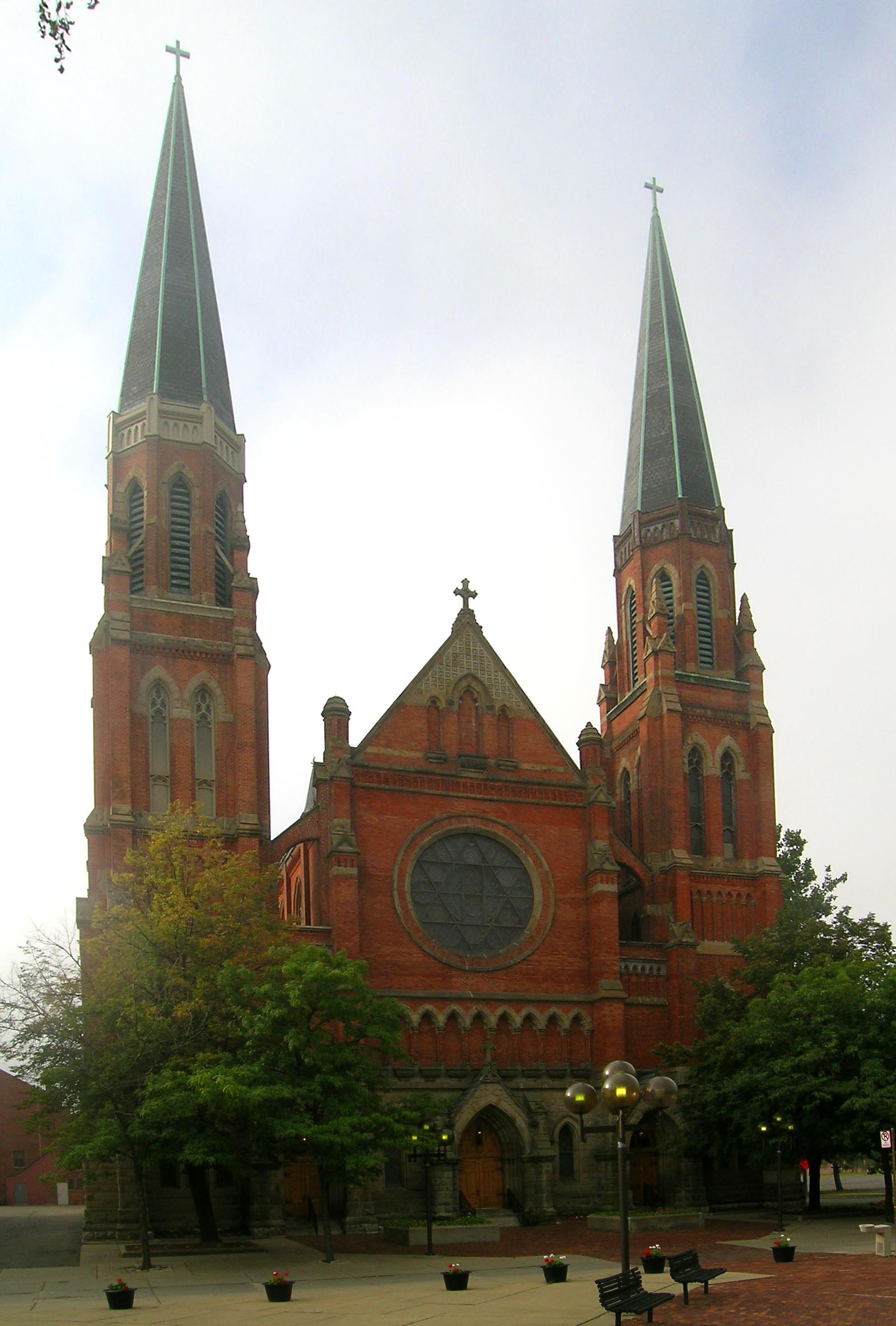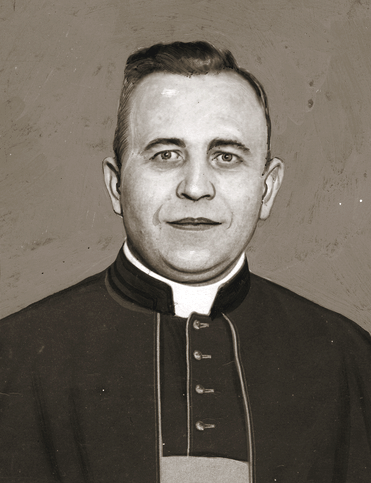|
Lawrence Wnuk
Lawrence (Wawrzyniec) Anthony Wnuk, (August 6, 1908 in Witrogoszcz, German Empire (now Poland) – August 6, 2006 in Windsor, Ontario, Canada) was a Polish Roman Catholic priest and Protonotary Apostolic. He grew up in a Catholic and patriotic Polish family. In 1928, after completing gymnasium in Nakło nad Notecią, Poland he entered Seminary in Gniezno, where he studied under professors Rev. Kazimierz Rolewski, Rev. Aleksander Żychliński, Father Michał Kozal (beatified martyr from Dachau). He was ordained in 1933 by Cardinal August Hlond and began work as an assistant in parishes in Inowrocław and from 1938 in Gniezno. When the Second World War erupted in 1939, he was arrested by the Gestapo and sent to Piotrków Trybunalski. On August 15, 1943 he was arrested again and taken to Oświęcim ( Auschwitz) concentration camp. There he caught the Typhus and fought for weeks with death. In June 1944, the Soviet offensive prompted the Germans to evacuate the camp to cover up th ... [...More Info...] [...Related Items...] OR: [Wikipedia] [Google] [Baidu] |
Witrogoszcz
Witrogoszcz is a village in the administrative district of Gmina Łobżenica, within Piła County, Greater Poland Voivodeship, in west-central Poland. It lies approximately north-east of Łobżenica, north-east of Piła, and north of the regional capital Poznań Poznań () is a city on the River Warta in west-central Poland, within the Greater Poland region. The city is an important cultural and business centre, and one of Poland's most populous regions with many regional customs such as Saint Joh .... References Witrogoszcz {{Piła-geo-stub ... [...More Info...] [...Related Items...] OR: [Wikipedia] [Google] [Baidu] |
Buchenwald Concentration Camp
Buchenwald (; literally 'beech forest') was a Nazi concentration camp established on hill near Weimar, Germany, in July 1937. It was one of the first and the largest of the concentration camps within Germany's 1937 borders. Many actual or suspected communists were among the first internees. Prisoners came from all over Europe and the Soviet Union—Jews, Poles and other Slavs, the mentally ill and physically disabled, political prisoners, Romani people, Freemasons, and prisoners of war. There were also ordinary criminals and sexual "deviants". All prisoners worked primarily as forced labor in local armaments factories. The insufficient food and poor conditions, as well as deliberate executions, led to 56,545 deaths at Buchenwald of the 280,000 prisoners who passed through the camp and its 139 subcamps. The camp gained notoriety when it was liberated by the United States Army in April 1945; Allied commander Dwight D. Eisenhower visited one of its subcamps. From August 194 ... [...More Info...] [...Related Items...] OR: [Wikipedia] [Google] [Baidu] |
Monsignor
Monsignor (; it, monsignore ) is an honorific form of address or title for certain male clergy members, usually members of the Roman Catholic Church. Monsignor is the apocopic form of the Italian ''monsignore'', meaning "my lord". "Monsignor" can be abbreviated as Mons... or Msgr. In some countries, the title "monsignor" is used as a form of address for bishops. However, in English-speaking countries, the title is dropped when a priest is appointed as bishop. The title "monsignor" is a form of address, not an appointment (such as a bishop or cardinal). A priest cannot be "made a monsignor" or become "the monsignor of a parish". The title "Monsignor" is normally used by clergy (men only) who have received one of the three classes of papal honors: * Protonotary apostolic (the highest honored class) * Honorary prelate * Chaplain of his holiness (the lowest honored class) The pope bestows these papal honors upon clergy who: * Have rendered a valuable service to the church * Pr ... [...More Info...] [...Related Items...] OR: [Wikipedia] [Google] [Baidu] |
Prelate
A prelate () is a high-ranking member of the Christian clergy who is an ordinary or who ranks in precedence with ordinaries. The word derives from the Latin , the past participle of , which means 'carry before', 'be set above or over' or 'prefer'; hence, a prelate is one set over others. The archetypal prelate is a bishop, whose prelature is his particular church. All other prelates, including the regular prelates such as abbots and major superiors, are based upon this original model of prelacy. Related terminology In a general sense, a "prelate" in the Roman Catholic Church and other Christian churches is a bishop or other ecclesiastical person who possesses ordinary authority of a jurisdiction, i.e., of a diocese or similar jurisdiction, e.g., ordinariates, apostolic vicariates/ exarchates, or territorial abbacies. It equally applies to cardinals, who enjoy a kind of "co-governance" of the church as the most senior ecclesiastical advisers and moral representatives of th ... [...More Info...] [...Related Items...] OR: [Wikipedia] [Google] [Baidu] |
Congregation Of The Ursulines Of The Agonizing Heart Of Jesus (Grey Ursulines)
The Congregation of the Ursulines of the Agonizing Heart of Jesus (Polish: ''Zgromadzenie Sióstr Urszulanek Serca Jezusa Konającego''), also known as the Grey Ursulines, is a Catholic order founded by Saint Ursula Ledóchowska in Poland. At present the Congregation consists of over 900 Religious sister, sisters in 14 countries. The sisters are committed to the service of poor people and specialize in providing educational opportunities. History The Congregation of the Ursulines of the Agonizing Heart of Jesus was founded in 1920 by Ursula Ledóchowska in Pniewy, Poland. During World War II the Ursuline Sisters convent in Warsaw ran a soup kitchen for orphaned or abandoned children in central Warsaw. The sisters were also active in efforts to obtain “Aryan” documents for the Jewish children, protect those who looked Jewish, and hide them during German raids. In 1997, Yad Vashem recognized Sister Andrzeja, (Maria Górska) as Righteous Among the Nations. During the German occupa ... [...More Info...] [...Related Items...] OR: [Wikipedia] [Google] [Baidu] |
London, Ontario
London (pronounced ) is a city in southwestern Ontario, Canada, along the Quebec City–Windsor Corridor. The city had a population of 422,324 according to the 2021 Canadian census. London is at the confluence of the Thames River, approximately from both Toronto and Detroit; and about from Buffalo, New York. The city of London is politically separate from Middlesex County, though it remains the county seat. London and the Thames were named in 1793 by John Graves Simcoe, who proposed the site for the capital city of Upper Canada. The first European settlement was between 1801 and 1804 by Peter Hagerman. The village was founded in 1826 and incorporated in 1855. Since then, London has grown to be the largest southwestern Ontario municipality and Canada's 11th largest metropolitan area, having annexed many of the smaller communities that surround it. London is a regional centre of healthcare and education, being home to the University of Western Ontario (which brands it ... [...More Info...] [...Related Items...] OR: [Wikipedia] [Google] [Baidu] |
Roman Catholic Archdiocese Of Detroit
The Archdiocese of Detroit ( la, Archidiœcesis Detroitensis) is a Latin Church ecclesiastical territory or archdiocese of the Catholic Church covering the Michigan counties of Lapeer County, Michigan, Lapeer, Macomb County, Michigan, Macomb, Monroe County, Michigan, Monroe, Oakland County, Michigan, Oakland, Saint Clair County, Michigan, St. Clair, and Wayne County, Michigan, Wayne. It is the metropolis (religious jurisdiction), metropolitan archdiocese of the List of Catholic dioceses in the United States#Ecclesiastical Province of Detroit, Ecclesiastical Province of Detroit, which includes all dioceses in the state of Michigan. In addition, in 2000 the archdiocese accepted pastoral responsibility for the Catholic Church in the Cayman Islands, which consists of Saint Ignatius Parish on Grand Cayman (the Roman Catholic Archdiocese of Kingston in Jamaica, Archdiocese of Kingston maintains a mission sui iuris, mission ''sui iuris'' jurisdiction over the Roman Catholic Mission Su ... [...More Info...] [...Related Items...] OR: [Wikipedia] [Google] [Baidu] |
Hamtramck, Michigan
Hamtramck ( ) is a city in Wayne County in the U.S. state of Michigan. As of the 2020 census, the city population was 28,433. Hamtramck is surrounded by the city of Detroit except for a small portion that borders the fellow enclave city of Highland Park. Hamtramck is by far the most densely populated municipality in the state of Michigan, and the only Muslim-majority town in the United States. Known in the 20th century as a vibrant center of Polish-American life and culture, Hamtramck has attracted new immigrants in the 21st century, especially from Yemen, Bangladesh and Pakistan. In 2013, it reportedly became the first Muslim-majority city in the U.S. In 2015, Hamtramck became the first city to have a Muslim-majority city council in the history of the United States, with four of the six council members being Muslim. In November 2021, Hamtramck elected a completely Muslim-American city council and a Muslim mayor, becoming the first municipality in the United States to be ... [...More Info...] [...Related Items...] OR: [Wikipedia] [Google] [Baidu] |
Allied Occupation Zones In Germany
Germany was already de facto occupied by the Allies from the real fall of Nazi Germany in World War II on 8 May 1945 to the establishment of the East Germany on 7 October 1949. The Allies (United States, United Kingdom, Soviet Union, and France) asserted joint authority and sovereignty at the 1945 Berlin Declaration. At first, defining Allied-occupied Germany as all territories of the former German Reich before Nazi annexing Austria; however later in the 1945 Potsdam Conference of Allies, the Potsdam Agreement decided the new German border as it stands today. Said border gave Poland and the Soviet Union all regions of Germany (eastern parts of Pomerania, Neumark, Posen-West Prussia, Free City of Danzig, East-Prussia & Silesia) east of the Oder–Neisse line and divided the remaining "Germany as a whole" into the four occupation zones for administrative purposes under the three Western Allies (the United States, the United Kingdom, and France) and the Soviet Union. Although the ... [...More Info...] [...Related Items...] OR: [Wikipedia] [Google] [Baidu] |
Józef Gawlina
Józef Feliks Gawlina, born in 1892 in Strzybnik ( Racibórz County) in Silesia - died 1964 in Rome was a Divisional general in the Polish Armed Forces. He was an ordained priest, Doctor of Theology and from 1933, Catholic bishop in the Military Ordinariate of Poland. After the Second world war, cardinal Hlond gave him the brief to provide pastoral care to the Polish diaspora. In the words of Pope John Paul II, Gawlina was a "bishop - Nomad". He was raised to the rank of Archbishop in 1957. Following his death, the Secretary General of the Second Vatican Council The Second Ecumenical Council of the Vatican, commonly known as the , or , was the 21st ecumenical council of the Roman Catholic Church. The council met in St. Peter's Basilica in Rome for four periods (or sessions), each lasting between 8 and ... described him as a "real pastor". References Bibliography * A. K. Kunert, ed. (2002)."Józef Feliks Gawlina Biskup Polowy Polskich Sił Zbrojnych" in ''Emigracyjna Rz ... [...More Info...] [...Related Items...] OR: [Wikipedia] [Google] [Baidu] |
Soest, Germany
Soest (, as if it were 'Sohst'; Westphalian: ''Saust'') is a city in North Rhine-Westphalia, Germany. It is the capital of the Soest district. Geography Soest is located along the ''Hellweg'' road, approximately south-west of Lippstadt, roughly east of Dortmund and roughly west of Paderborn. Neighbouring places *Bad Sassendorf *Ense *Lippetal *Möhnesee *Werl *Welver Legends The Norwegian Þiðrekssaga from the 13th century, a series of tales about the Gothic King Theoderic the Great, identifies Soest (called Susat) as the capital of Attila's (?–453) Hunnic Empire. The actual location of Attila's capital has not been determined. History Owing to its fertile soil (predominantly brown silty clay loam), the area around Soest is believed to have been settled well before the village is first mentioned in the ''Dagobertsche Schenkung'' in 836. Excavations in recent decades have uncovered signs of habitation stretching back more than 4000 years. During the 11th and 12th ce ... [...More Info...] [...Related Items...] OR: [Wikipedia] [Google] [Baidu] |





